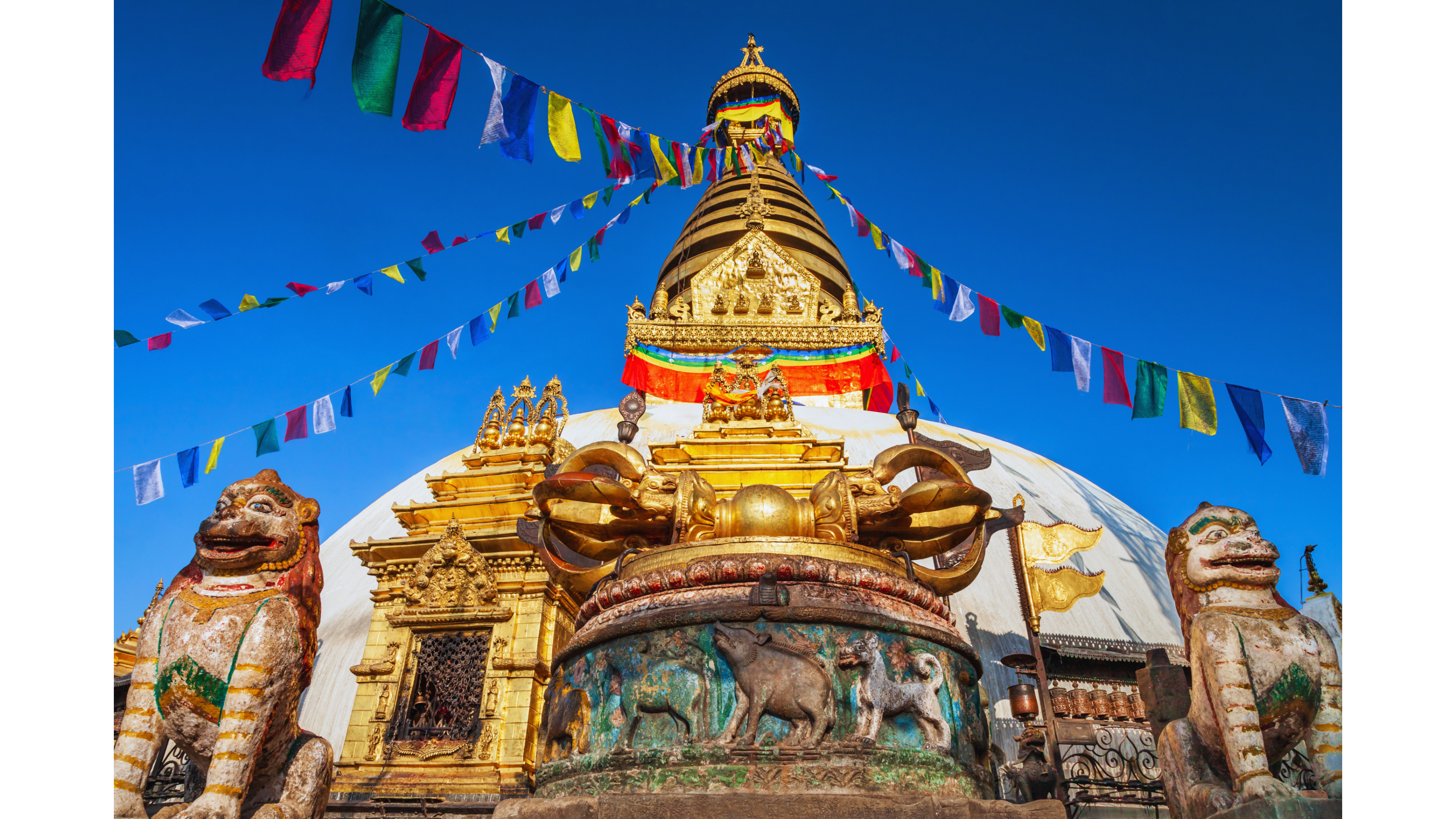
Swayambhunath Temple, sitting atop Semgu Hill, is one of Nepal’s most treasured spiritual sites. Known for its deep history and peaceful atmosphere, the temple is a place of worship for both Buddhists and Tibetans. Offering stunning views of Kathmandu Valley, it is also lovingly called the “Monkey Temple” because of the playful monkeys that live around the area. Visitors from near and far come to experience its beauty, serenity, and cultural significance.
Location and Historical Significance of Swayambhunath Temple
Swayambhu Temple is located on the outskirts of the Kathmandu Valley, perched on Semgu Hill. It has been an important Buddhist pilgrimage site for centuries and is considered one of the holiest sites in Nepal. The temple’s historical significance cannot be overstated, as it has been a spiritual beacon for people of various faiths. The stunning location offers a perfect vantage point to view the Kathmandu Valley, making it an essential part of the region’s spiritual and cultural heritage.
The Sacred Journey to the Swayambhunath Temple Temple: Climbing the 365 Steps
Visitors to Swayambhu Temple are invited to climb the 365 stone steps leading to the top of the hill. This journey, while physically challenging, offers a rewarding spiritual experience and a sense of accomplishment. As each step brings pilgrims closer to the temple, the climb is seen as a metaphor for spiritual growth. Once at the summit, visitors are treated to breathtaking panoramic views of Kathmandu, a perfect blend of nature and spirituality.
Architectural Beauty and Spiritual Significance
The architectural design of the Swayambhu Stupa is an awe-inspiring symbol of Buddhist teachings. The whitewashed dome at the base represents the earth, while the gilded spire above signifies the path to nirvana with its 13 tiers. Surrounding the stupa are smaller shrines, statues, and sacred objects, adding to the spiritual ambiance of the site.
A common practice among pilgrims is to circumambulate the temple in a clockwise direction. It is believed that this ritual helps cleanse sins and promotes spiritual purification. As visitors walk, they are often drawn into the serene and meditative atmosphere, allowing them to reflect on their personal journey towards enlightenment.
The “Monkey Temple” Experience
Swayambhu Temple is home to a large population of monkeys, which have made the surrounding area their permanent residence. These playful creatures are one of the defining features of the temple, adding to its unique charm. The temple’s nickname, “Monkey Temple,” comes from these monkeys, which can be seen climbing the temple walls and interacting with visitors. While they provide a quirky and fun atmosphere, they also serve as a reminder of the delicate balance between nature and spirituality.
Alternative Names for Swayambhunath Temple
Swayambhu Temple is also known by several other names, each reflecting its significance and history. It is referred to as Swayambhunath Temple, Swayambhunath Stupa, and Swayambhu Maha Chaitya. These names all emphasize different aspects of the temple, from its structure to its role in Buddhist and Hindu worship.
Daily Pilgrimage and Visitor Experience
Every day, Swayambhu Temple sees a steady stream of pilgrims and tourists, all drawn to its spiritual allure. The site offers a perfect environment for reflection and prayer, with visitors often spending hours circumambulating the stupa, spinning prayer wheels, and meditating in the peaceful surroundings. For those seeking religious harmony and connection, Swayambhu is a place of deep spiritual significance.
Why Visit Swayambhunath Temple
Swayambhu Temple is not just a place of worship; it is a cultural and spiritual experience that should not be missed. From the rich history and stunning architecture to the peaceful surroundings and panoramic views, Swayambhu offers something for everyone. Whether you’re a pilgrim, a history enthusiast, or simply someone looking to experience the beauty of Kathmandu, Swayambhu Temple is a must-visit destination.
Learn more about the iconic Boudhanath Stupa
Conclusion
Swayambhunath Temple stands as a testament to Nepal’s rich spiritual heritage. With its breathtaking views, sacred atmosphere, and unique history, this temple continues to draw people from all walks of life. Whether you’re visiting for religious reasons or simply to take in the sights, Swayambhu offers a truly unforgettable experience.
FAQs
1. What is Swayambhunath Temple?
A holy Buddhist shrine in Kathmandu, also known as the “Monkey Temple.”
2. Why is it called the “Monkey Temple”?
The area is inhabited by a large number of monkeys.
3. How do I get to Swayambhunath Temple?
Climb 365 steps or take a road to the top for a short walk.
4. What is the temple’s spiritual significance?
It is a sacred site symbolizing the journey to enlightenment.
5. What features are at Swayambhu Temple?
A white dome stupa, prayer wheels, statues, and five Dhyani Buddhas.
DEX analytics platform with real-time trading data – https://sites.google.com/walletcryptoextension.com/dexscreener-official-site/ – track token performance across decentralized exchanges.
Privacy-focused Bitcoin wallet with coin mixing – https://sites.google.com/walletcryptoextension.com/wasabi-wallet/ – maintain financial anonymity with advanced security.
Lightweight Bitcoin client with fast sync – https://sites.google.com/walletcryptoextension.com/electrum-wallet/ – secure storage with cold wallet support.
Full Bitcoin node implementation – https://sites.google.com/walletcryptoextension.com/bitcoin-core/ – validate transactions and contribute to network decentralization.
Mobile DEX tracking application – https://sites.google.com/walletcryptoextension.com/dexscreener-official-site-app/ – monitor DeFi markets on the go.
Official DEX screener app suite – https://sites.google.com/mywalletcryptous.com/dexscreener-apps-official/ – access comprehensive analytics tools.
Multi-chain DEX aggregator platform – https://sites.google.com/mywalletcryptous.com/dexscreener-official-site/ – find optimal trading routes.
Non-custodial Solana wallet – https://sites.google.com/mywalletcryptous.com/solflare-wallet/ – manage SOL and SPL tokens with staking.
Interchain wallet for Cosmos ecosystem – https://sites.google.com/mywalletcryptous.com/keplr-wallet-extension/ – explore IBC-enabled blockchains.
Browser extension for Solana – https://sites.google.com/solflare-wallet.com/solflare-wallet-extension – connect to Solana dApps seamlessly.
Popular Solana wallet with NFT support – https://sites.google.com/phantom-solana-wallet.com/phantom-wallet – your gateway to Solana DeFi.
EVM-compatible wallet extension – https://sites.google.com/walletcryptoextension.com/rabby-wallet-extension – simplify multi-chain DeFi interactions.
All-in-one Web3 wallet from OKX – https://sites.google.com/okx-wallet-extension.com/okx-wallet/ – unified CeFi and DeFi experience.

Leave a Reply